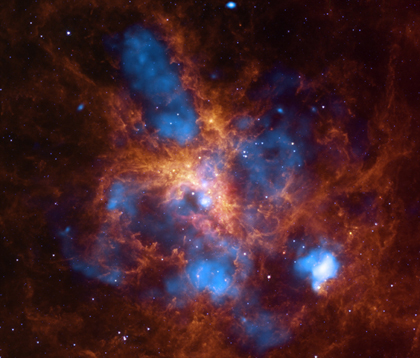30 Doradus and The Growing Tarantula Within
The star-forming region, 30 Doradus, is one of the largest located close to the Milky Way and is found in the neighboring galaxy Large Magellanic Cloud. About 2,400 massive stars in the center of 30 Doradus, also known as the Tarantula Nebula, are producing intense radiation and powerful winds as they blow off material.
Multimillion-degree gas detected in X-rays (blue) by the Chandra X-ray Observatory comes from shock fronts -- similar to sonic booms --formed by these stellar winds and by supernova explosions. This hot gas carves out gigantic bubbles in the surrounding cooler gas and dust shown here in infrared emission from the Spitzer Space Telescope (orange).
30 Doradus is also known as an HII (pronounced "H-two") region, created when the radiation from hot, young stars strips away the electrons from neutral hydrogen atoms (HI) to form clouds of ionized hydrogen (HII). It is the most massive and largest HII region in the Local Group of galaxies, which contains the Milky Way, Andromeda and about 30 other smaller galaxies including the two Magellanic Clouds. Because of its proximity and size, 30 Doradus is an excellent target for studying the effects of massive stars on the evolution of an HII region.
More at http://chandra.harvard.edu/photo/2011/30dor/
-Megan Watzke, CXC
Category:
- Log in to post comments

